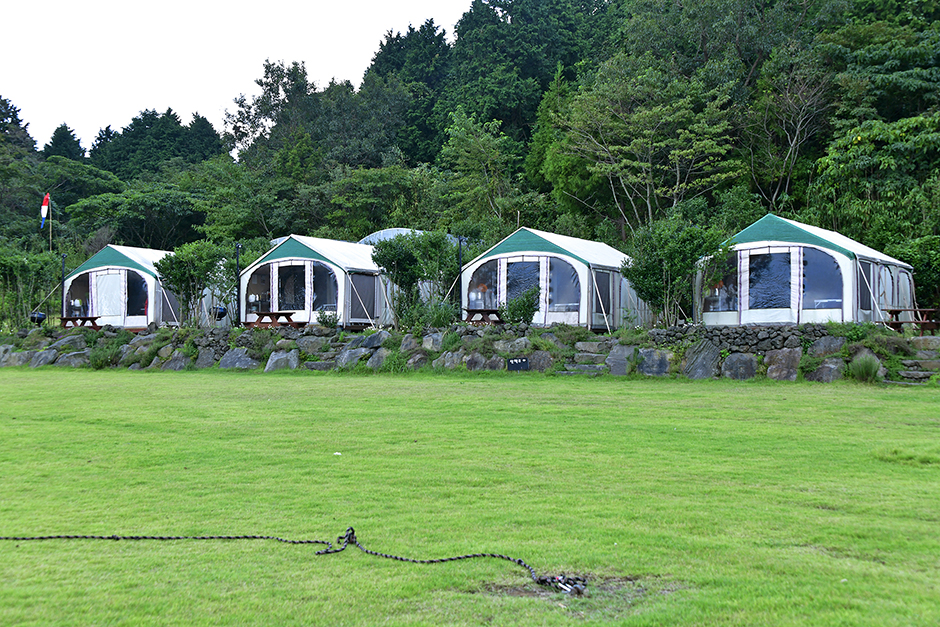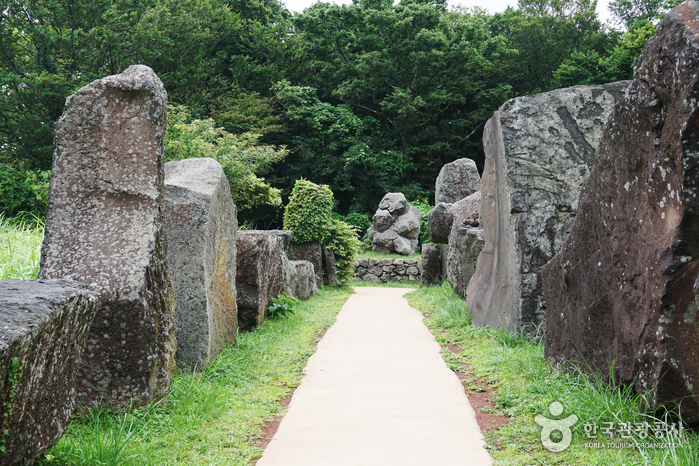Dangcheomuldonggul Cave [UNESCO World Natural Heritage Site] (당처물동굴 [유네스코 세계자연유산])
8.7Km 20850 2020-04-23
Woljeong-ri, Gujwa-eup, Jeju-si, Jeju-do
+82-1600-0064
Dangcheomuldonggul Cave, located in Jeju, is a lava tube estimated to have been formed some 320,000 years ago due to volcanic activity; it is located approximately 3 kilometers underground. With no entrance as such, the cave is not open to the general public and thus its original form remains preserved to this day, giving it a high geological value.
Although the Dangcheomuldonggul Cave is technically a lava tube, it resembles a limestone cave due to the secondary geological formations
of lime substances that have accumulated in the ground above the tube. The tunnel has a spectacular and mystical beauty with countless stalactites and stalagmites, as well as stalactite columns. The particularly thin stalactites and stalactic columns in this cave are well-known for their uniqueness and beauty. Although this is a relatively small lava tunnel, its exotic colors and the richness of the secondary topological formations make it extraordinary in terms of research value. This cave has been designated natural monument.
* The UNESCO World Heritage inscribed Geomun Oreum Lava Tube System consists of Bengdwigul, Manjanggul Cave, Gimnyeonggul, Yongcheondonggul and Dangcheomuldonggul Caves.
Samyang Beach (삼양해수욕장)
9.4Km 37763 2022-07-28
Samyang 2-dong, Jeju-si, Jeju-do
+82-64-740-6000
Samyang Beach is cozy and has clear waters because it is not well-known among tourists. In particular, it stands out because of its sparkling black sand. As the black sand's therapeutic effect is well known, visitors can often be seen lying down on the beach and burying themselves in the black sand.
Eco Land Theme Park (에코랜드테마파크)
9.4Km 85954 2023-01-17
1278-169, Beonyeong-ro, Jeju-si, Jeju-do
+82-64-802-8000
Eco Land Theme Park is built in the 1 km² Gotjawal primeval forest. Visitors can explore around in a train that looks like an 1800s steam-powered Baldwin train. The seven Baldwin train look-alikes (Lincoln Train) operated in the park were specially ordered and manually manufactured in the UK. In the large Gotjawal forest with railway trails, visitors can see a variety of plants, animals, and insects living in the mysterious Gotjawal forests, while touring around by special train. It also has a lake for visitors to experience the ecosystem of the forest, take a walk and enjoy a picnic. Besides, there are many things to enjoy including Eco Bridge, Eco Windmill, Picnic Garden, Kid’s Town, Eco Road, Bare Foot on Scoria, Floating Café, and topiary artworks.
Geomunoreum Lava Tube [UNESCO World Natural Heritage Site] (거문오름 [유네스코 세계자연유산])
9.4Km 54870 2024-03-13
Seonheul-ri, Jocheon-eup, and Deokcheon-ri, Gujwa-eup areas in Jeju
+82-64-710-8981
Geomunoreum Lava Tube stands out as one of the distinct oreum (the Jeju language term for parasitic cones) on Jeju Island, marked by its extensive network of around 20 lava tubes running through the volcanic structure. This site is not only a geological marvel but also a sanctuary for diverse biological species. Visitors begin their journey at the Jeju World Natural Heritage Center, from where a path leads directly to the Geomunoreum Lava Tube. It is important to note that prior reservations are required to visit. The significance of this location as a key geological feature was recognized when it was designated as a UNESCO World Natural Heritage Site in 2007. Additionally, an international trekking event is hosted annually to celebrate its global importance.
Jeju World Natural Heritage Center (제주 세계자연유산센터)
9.4Km 25386 2021-05-31
569-36, Seongyo-ro, Jeju-si, Jeju-do
+82-1800-2002
The Jeju World Natural Heritage Center was established to acknowledge Jeju Island’s value as the sole UNESCO World Natural Heritage in Korea. It is comprised of various facilities including a 4D video room, lava tunnel experience, origins of Jeju-do, and many other activities that visitors can experience first-hand. Jeju World Natural Heritage Center is located in the Geomunoreum Lava Tube System, which was designated as a UNESCO World Natural Heritage in 2007, one of the 20 ecological tourism spots selected by the Ministry of Environment of Korea in 2009, as well as a Korean-style ecological tourism model.
* Opening date: September 4, 2012
Bengdwigul Cave [UNESCO World Natural Heritage Site] (제주 선흘리 벵뒤굴 [유네스코 세계자연유산])
9.6Km 21617 2022-12-27
Jocheon-eup, Jeju-si, Jeju-do
+82-1600-0064
With a total length of 4,481 meters, Bengdwigul Cave is shaped like a maze and has one of the most complex lava tube structures in the world. For geologists, this cave is invaluable since it demonstrates how lava continuously flowed over the surface of the ground and the complex route it took to eventually form a tube deep underground. Created particularly close to the earth’s surface, this cave has a number of entrance holes to the tunnel. Inside, the complex structure of the cave unfolds in the form of double-tiered or triple-tiered rooms. A range of lava formations such as lava columns and lava bridges have developed inside this mystical tube.
* The UNESCO World Heritage designated Geomunoreum Lava Tube System of Bengdwigul, Manjanggul Cave, Gimnyeonggul, Yongcheondonggul and Dangcheomuldonggul Caves.
Woljeongri Beach (월정리해변(월정리해수욕장))
9.8Km 30958 2023-01-17
480-1, Haemajihaean-ro, Jeju-si, Jeju-do
+82-64-740-6000
Woljeong-ri, a village located on the east side of Jeju Island, holds the meaning "the moon stays." The beautiful emerald sea spreads out like a picture, and the bright moon shines above it. As more and more travelers visited the beach to appreciate its beauty, many restaurants, cafes, and lodging facilities started to form along the shoreline. Some cafes placed chairs for people to relax in while looking at the sea, which became an iconic photo spot of Woljeongri Beach.
The beach is also a popular location for a variety of water sports such as surfing, snorkeling, and kayaking. Woljeongri Beach is popular among surfers because it has waves with a uniform x_height that are constantly coming in. The beach is also a part of the Gimnyeong-Hado Olle and Gimnyeong-Woljeong Geotrail Course on Jeju Olle Trail Route 20, and a great spot for tourists to take a break while taking in the beautiful scenery and cool scent of the sea.
Jeju Best Hill (제주베스트힐)
9.9Km 0 2024-03-20
2109-36 Namjo-ro, Jocheon-eup, Jeju-si, Jeju-do
Best Hill is a campground at Namjo-ro, Jeju, at the foot of Banongoreum Parasitic Cone, surrounded by Gotjawal, a jungle-like forest featuring ferns growing on stone-rich land. It is located about 20 to 30 minutes from Jeju International Airport, so it is a good base camp for the surrounding tourist sites as well. Onsite facilities include the pension itself, glamping campground, drone game range, 3D experience, and hot air balloon experience. The pension features a variety of room arrangements, from Camellia to Herb, Meditation, Family, and Experience Rooms, for groups of all sizes. The glamping campground has private bathrooms attached to each tent for convenience. The hot air balloon experience allows riders to take part in the take-off and landing processes. There's a large grassy playground for kids and a covered swimming pool in the summer for hours of fun. Nearby sights include Eco Land Theme Park, Jeju Stone Park, Hamdeok Beach, and Saryeoni Forest Trail.
Lotte Himart - Samhwa Branch [Tax Refund Shop] (롯데하이마트 삼화점)
10.2Km 0 2024-04-19
888, Yeonsam-ro, Jeju-si, Jeju-do
-
Jeju Stone Park (제주돌문화공원)
10.2Km 51156 2024-01-11
2023 Namjo-ro, Jocheon-eup, Jeju-si, Jeju-do
Located in Jocheon-eup, Jeju-si, Jeju Stone Park was inspired by Jeju's culture and applications of stones. The main theme focuses on the foundation and identity of Jeju Island, based on the myth of Seolmundae Halmang (Grandmother Seolmundae), who created Jeju Island and the stones of Obaek Janggun (Five Hundred Generals). The park serves as a historical and cultural space where collected stones respresent Jeju's foundation and culture.

![Geomunoreum Lava Tube [UNESCO World Natural Heritage Site] (거문오름 [유네스코 세계자연유산])](http://tong.visitkorea.or.kr/cms/resource/62/2661662_image2_1.jpg)

![Lotte Himart - Samhwa Branch [Tax Refund Shop] (롯데하이마트 삼화점)](http://tong.visitkorea.or.kr/cms/resource/64/2887664_image2_1.jpg)

 English
English
 한국어
한국어 日本語
日本語 中文(简体)
中文(简体) Deutsch
Deutsch Français
Français Español
Español Русский
Русский